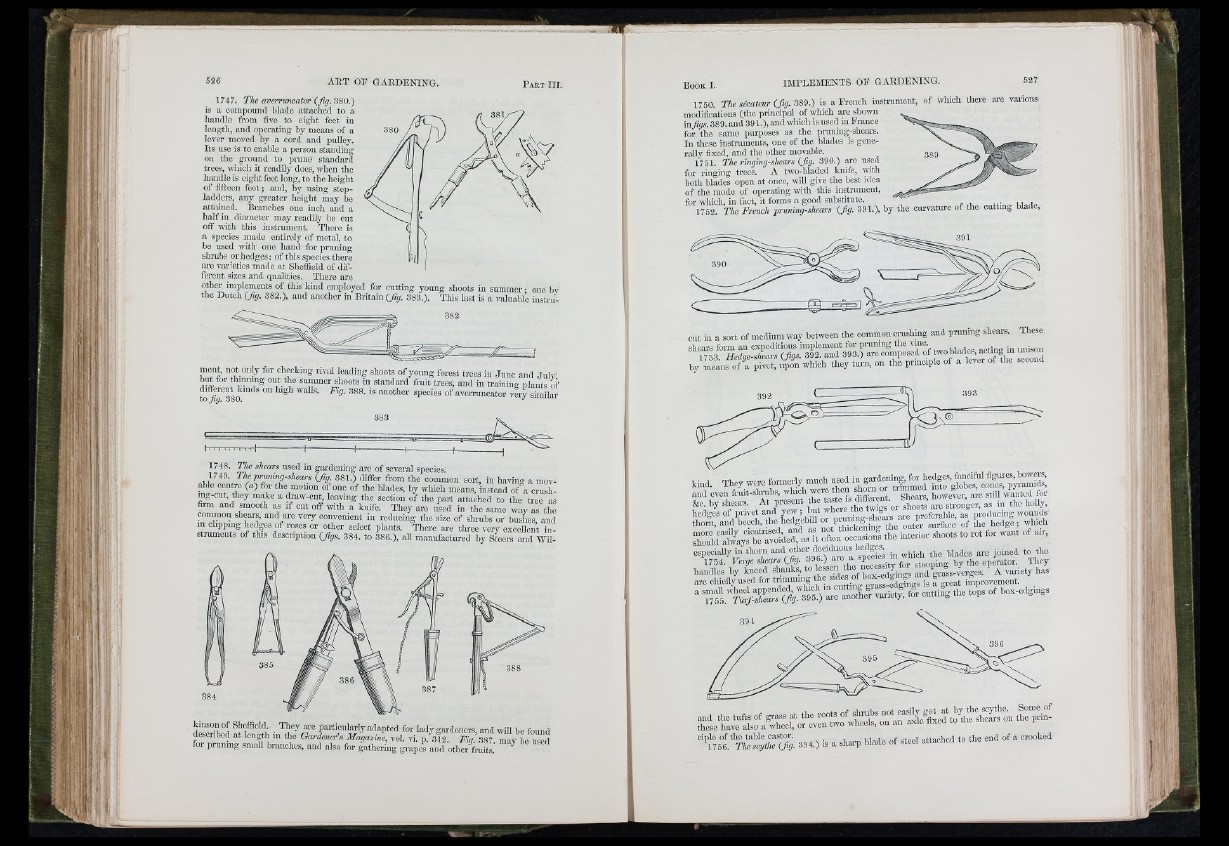
? :Ü Î
■c -''Xk'J' a ■ !■'
S ' - '
1747. The averruncator (Jig. 380.)
is a compound blade attached to a
handle from five to eight feet in
length, aud operating by means of a
lever moved by a cord and pulley.
Its use is to enable a person standiiig
on the ground to prune standard
trees, which it readily does, Avheu the
handle is eight feet long, to the height
of fifteen fe e t; and, by using step-
ladders, any greater height may be
attained. IBranches one inch and a
half in diameter may readily be cut
off with this instrument. There is
a species made entirely of metal, to
be used with one hand for pinning
shnibs or hedges: of this species there
are varieties made at Sheffield of different
sizes and qualities. There arc
other implements of tliis kind employed for cutting young shoots in summer • one bv
the Dutch (Jig. 382.), and another in Britain (Jg . 383.). This last is a valuable instrument,
not only for dicckmg rival leading shoots o f young forest trees in June and Ju ly
but for thnming out the sununer shoots in standard fmit trees, and in training plants of
to ^ ? 3 8 0™ ™ " “ “ ft'' "P“ "® of ™ y simihir
383
h 1 ^ ^ ^
1748. The shears used in gardening are of several species.
«1 L L ' s ( f y 381.) differ from the common sort, in having a movable
centre (a) for the motion of ono of the blades, by winch means, instead of a crush-
mg-cut, they make a iraw-out, leaving the section of the part attached to the tree as
firm and smooth as if out off with a knifo. They are used in the samo way as the
common shears, and are very convement in rcducing the size of shrubs or bushes, and
T*>ore are tlu-ce very excellent in-
struments of this description (Jigs. 384. to 386.), all manufactured by Steers and Wilkinsonof
Shefflcld ^ They are par-ticiil.arly adapted for lady g.wdeners, and will bo found
desciibed at length in the Gardener’s Magazine, vol. vi. p. 312. Fig. 387 may be used
fol praning small branches, and also for gathering gi-apes and other fruits
1750. The sécateur (Jig. 389.) is a Fi-encb instrament, of ivhich there aró vai-ious
modifications (the principal of wliich are shown
in figs. 389. and 391.), and wliicb is used in France
for the same purposes as the praning-shears.
In these instrainents, one of the blades is generally
fixed, and the other movable.
1751. The ringing-shears (fig. 390.) arc used
for ringing trees. A two-bladed knife, lyith
both blades open at oncc, will give the best idea
of the mode of operating with this instrumciit,
for wliich, in fact, it foi-ms a good substitute. " « æ „
1762. The French pruning-shears (fig. 391.), by the curvatm-e of the cuttmg blade.
cut in a sort of medium way between the common crashing and pruning shears. These
by means of a pivot, upon wliich they turn, on tbe prmciple of a lover ot tho second
thorn, and bceeh, the hedgcbrd " P ,ra-faee’ of the hedge; which
» r a L d c L M X n t t f ! the interior shoots to rot for want of arr,
espcciaUy in thorn and o t e r deciduous le gcs joined to the
arc chiefly used for trnmmrng rg v e a t toprovemeut.
a small whceteppended,_V liC C i ibpp'-ib'-i-.-vi, wdrieh ..........
m v,o^_edgings
1755.
Tutf-shears (fig. 395.) are i
304.) is a Shm-p blade of steel attached to the end of a er-ooked